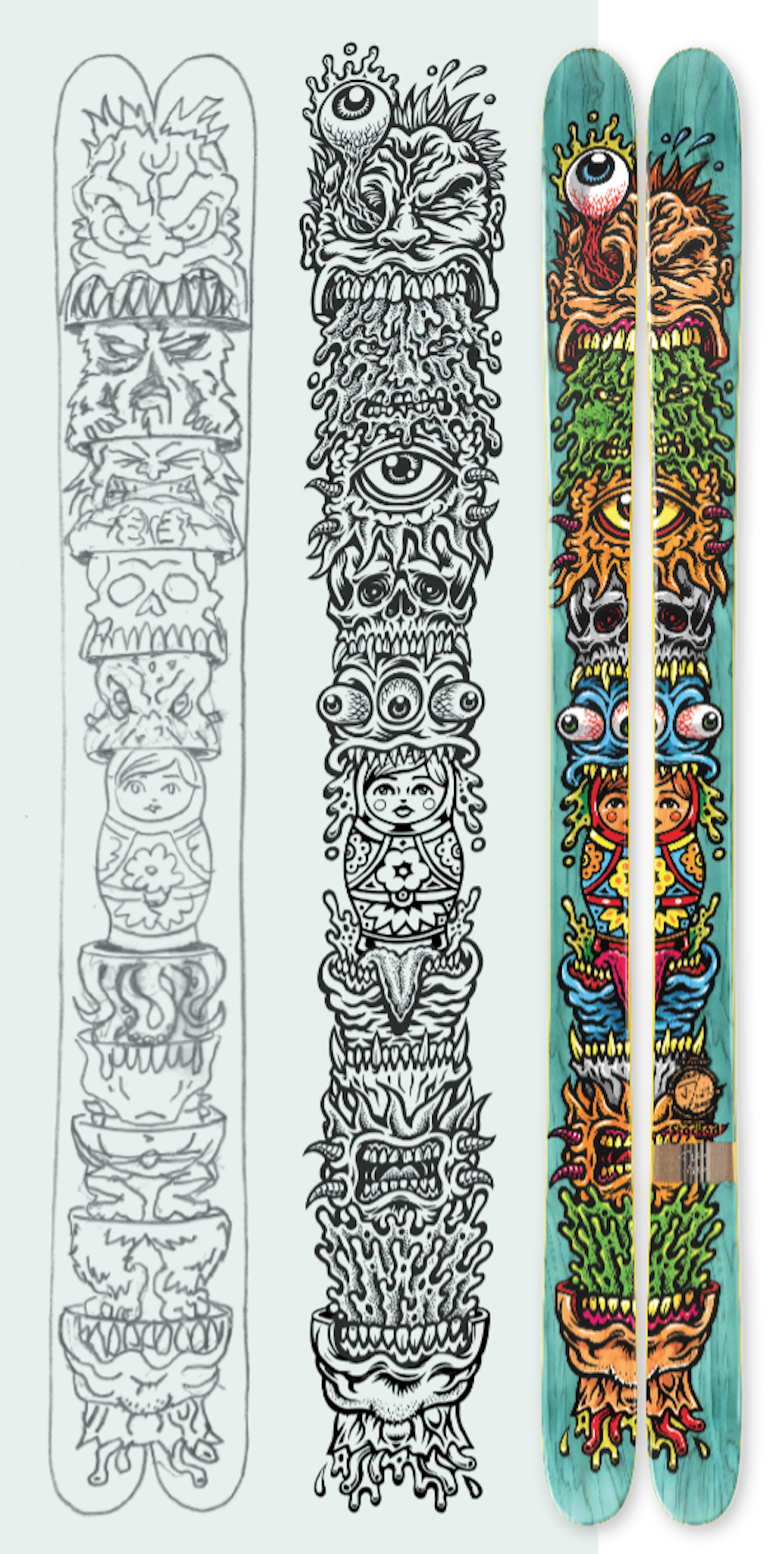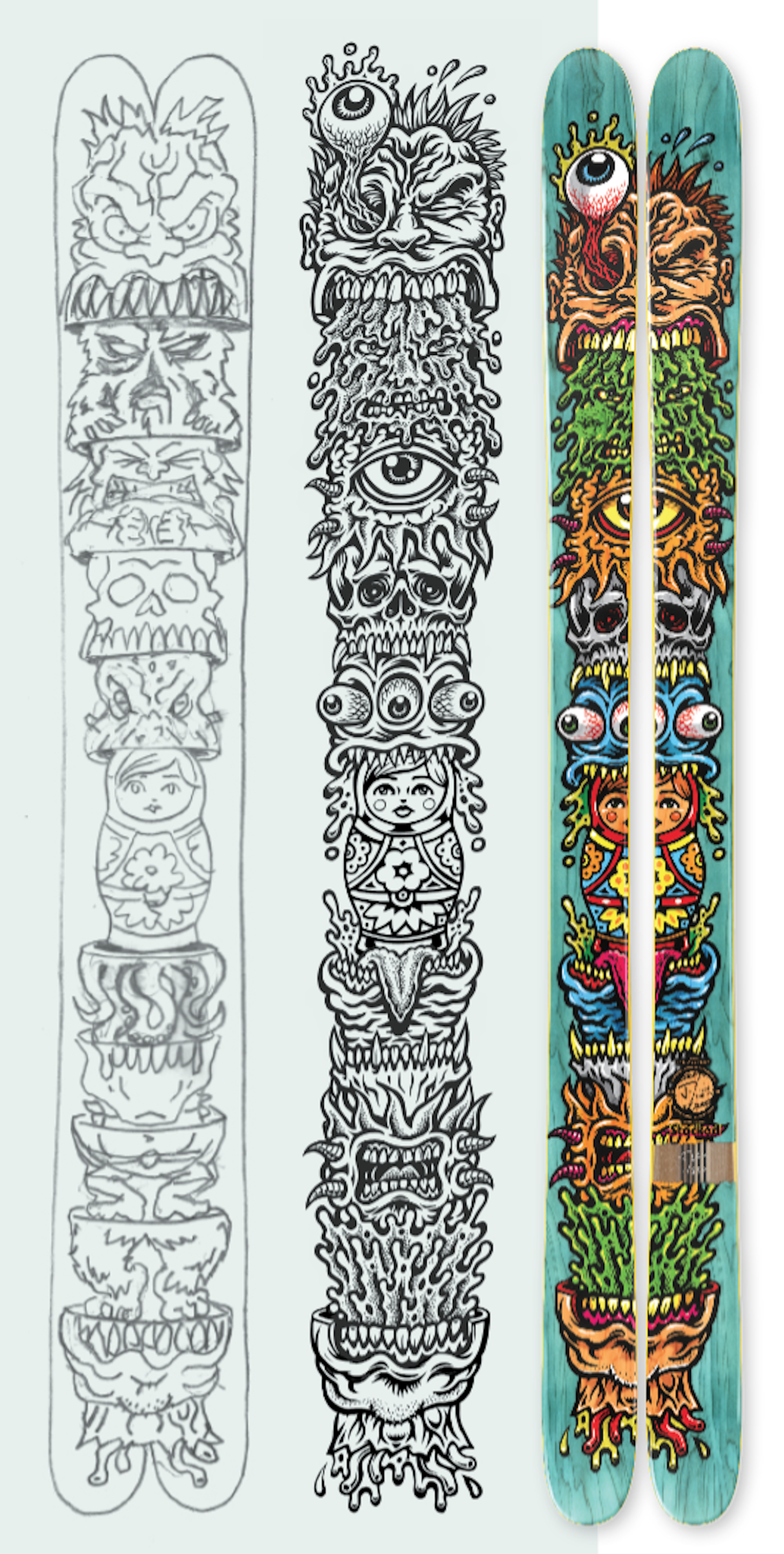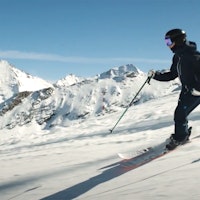INTERVIEW — Samuel Taggart
For Jimbo Phillips, illustration runs in the family. As a youngster, Jimbo took cues from his dad, Jim, one of the first artists to bring colorful artworks to skate decks, forever fusing the two. Nowadays, a blank skateboard deck is as rare as an albino elephant—and more recently the skiing world has caught onto the trend of utilizing skis as a canvas. Back in 2010, Jason Levinthal leaned on Jimbo to design the ever-popular Line Afterbang skis and last season the two paired up again to work on a limited edition model of the J skis Allplay, coined the “Stacked” collab. Jimbo, a self-taught artist, is one that thrives in a colorful, weird world of twisted figures, full of bold lines, big colors and, quite literally, eye-popping splashes of the grotesque. Although the “Stacked” Allplay skis are completely sold out—only 350 pairs were made in total—we were still curious to hear the full story behind the jaw-dropping graphics. Here’s the inside scoop from the mad mind behind the art.
How did your pops set the stage for artists like yourself in the action sports scene?
My dad really opened up a lot of doors, paved the way. He had to fight for a lot of things—he was ahead of his time because people weren’t totally ready for super crazy graphics and artwork. He was inspired by Mad Magazine, old cartoons and comics, and always had this tendency towards funny, creative, outlandish art. He had to work long hours for a small amount of pay just because he had to take what jobs he could get. He really got in at the ground floor of skateboard graphics. When he started, Santa Cruz didn’t even have art on their skateboards—they started off with checkers and stripes and [basic designs]. But once they [used his art] it really took off.
As an artist, what did you learn from your father?
I didn’t realize how much I was soaking up [when I was younger] and, when it came time to utilize those skills, I was like: “Oh yeah, I know how to do this.” He would show me little tricks for shading and line work—he was really a master of line work. I always loved that about his art, so I always wanted to have that kind of style in mine. I’ve utilized that over the years and it’s become a trademark of Phillips style.
That’s the thicker outlines, comic-esque look?
Yes. A lot of that was established because of screen printing skateboard decks back in the day; you had to have a thicker line to trap the colors behind it. But it also makes the artwork really bold—so you can see it from far away. You’d be across the street and you could see the [skateboard] graphic and know the artist right away.
Where do you draw your inspiration? The same places as your dad?
He definitely turned me onto a lot of that stuff when I was kid: He’d always buy me Mad Magazines and they’d just show up in my room. I’d be like, “Oh, where’d this come from?” And I’d start flipping through it. Saturday morning cartoons and a lot of the old monster movies—Frankenstein and Dracula and that kind of stuff—also caught my eye. Later on, punk and heavy metal album covers [were my inspiration]. I’d go down to the record store and flip through the collections. I’d only have enough money for one record, but I would look at all the album covers when I was there. I bought an Iron Maiden album just on the cover alone.
So, music inspires your art as well?
I always have music on [when I’m working]. Music is a big deal for me to get inspiration and just gets me amped up. I’ll put on Reggae if I’m in a chilled mood. But a lot of times I put on some punk or metal or some Tool to get in the zone. Music gets your gears turning and the creative juices flowing.
The idea of using skis as a canvas for art is relatively new. So, when the team at J skis approached you about this collaboration, what was your reaction?
I was all on-board. For me it just resonates… like putting art on skateboards, it just seems like such a mandatory thing. You have to have cool graphics on your skateboard! To me, that translates to snowboarding, skiing, even a hockey stick should have some cool art on it. If you can get some graphics on there, make it look cool.
There’s a reciprocal relationship between choosing a skateboard deck or skis with rad art on them, like it might make you ride better, looking down at the art while you’re heading down the mountain.
For sure. When you’re on the lift, sitting there, you have that “space out” time. You could be looking at some blank skis or you could be looking at some cool art on your skis… why not have a little spice on there? Skateboarding really set a precedent for that in big ways because graphics on skateboards is cemented into the culture. A blank skateboard is rare, but it takes a while for that idea to catch.
Did J skis have an idea for you to work with or did they just let you work your magic?
I had worked with J [Jason Levinthal] back in the Line Skis days and we did a graphic for the Afterbang skis. When he started his own brand and came back to me and said, “We want to do another one.” I was immediately all-in. He had an idea for the Russian Dolls. But that was just a concept, so I just took that idea and ran with it.
Were the checkerboard bases an homage to some of the old Santa Cruz stuff?
Yes, that’s a classic, old school skate vibe thrown in there.
Your work can be—for lack of a better way to say it—somewhat grotesque, with characters throwing up green slime and eyeballs shooting out of their sockets. Do you ever get any negative responses from people that see your work?
In the past, it used to be a little more frequent and I would get, “Well, can we tone it down a bit?” Stuff like that. I would just see the potential and then go nuts with it. So I always push for that. But, as the years have gone on and my art has been established, people recognize that style and that’s what they want. Sometimes I think, “Oh, I shouldn’t be too crazy.” And then they’re like, “Oh man, we really wanted the eyes popping out!” So it’s gotten a lot more open lately—people come to me for that vibe.
Seems like you have a few recurring caricatures that you throw into your work? Did you purposely include those images on these J skis?
Yes, some of the classics, like the slime guy and the guy with the eyeballs flying out. I feel like when you have a range of characters, it’s fun to fit those guys in there because people recognize them.


Throughout the three decades of being an artist, did you ever feel a pull away from art, to not follow so closely in your dad’s footsteps?
I definitely had some lean times in my early years, but I’ve never regretted my decision to become an artist. It’s where I belonged and it’s always felt right to me.
What’s been the most disconnected project you’ve worked on? Skate and ski brands obviously fit well with your work, but was there ever a time you were commissioned that felt out of place?
Sometimes I’ll get commissioned to do something that’s a little out of my wheelhouse… recently I’ve done some murals and I hadn’t done a lot of murals before. It’s a big undertaking and you have to use different tools. Sometimes I get halfway through and think, “What the heck did I bite off here?” But then you just keep grinding away at it and, eventually, you get to a spot where you’re flowing. I like to take on things like that—you have keep the learning process in there, adopt new skill sets and break out of the box, so to speak.
Has your style evolved over the years?
When computers first came into the picture, Photoshop was [on my mind]. You could really go to town with the shading. I experimented with a lot of that, but then I realized that I preferred the bold line art and went back to that. I try and stick with that, for the most part. I’ll deviate a bit, but there’s a lot you can do within that style so I don’t really feel restricted or anything.
But you seem to prefer that analog experience of getting something down pen to paper…
Computers can make things… a lot easier. I love them and it does help a lot. But, at the same time, sometimes you just want to break out of that and just go back to basics.
What materials and mediums do you gravitate toward when you’re creating a piece?
I’ll always start with just a sketch, just pencil and paper, to see how the ideas flow. Then I’ll get the template and sketch [those thumbnails] into the template and see where things fit. Next, I’ll use an overlay—I have a light table and I’ll just overlay it, ink out the drawing over the pencil. Or sometimes I’ll ink it on the tablet, just put the sketch in the computer and ink it. This kind of work always gets scanned into the computer at some point and that allows for you to mess with colors and change the composition more easily.
Do you ever illustrate directly onto a skateboard deck or other real-life objects? How does that change your approach to creating the art?
There’s no undo button! You can get a little looser with smudging paint and being a little messier, a little looser. When you paint a board, you do that squinty-eye thing where you look back a little bit and you’re like, “Okay, that works.” But you can’t zoom in 200 times [to check the fine details] so it’s just what your eye sees that looks good. You just go with it.
What’s interesting about the J skis model is that they only make a limited number of the certain collaborations. Once it’s sold out, it’s gone. I wonder how that changes the consumer’s mindset?
From a collector’s standpoint… when you see that release, you know that you have to scoop it up while it’s available or else it’s going to be gone and the price is going to double later. It creates a little frenzy of people wanting to get it. Once it sells out, that definitely adds to the mystique of the ski or the deck.
Having grown up around skateboard culture, I wonder what skiing can learn from skate culture and what skate culture can learn from ski culture?
Just the freedom. They’re similar in that way, just finding the freedom when you go out there, when there’s no rules, no one telling you what to do. You just do whatever feels right, whatever is fun to you. Sometimes people will say, “You did that trick wrong.” But, really, that stuff doesn’t matter as long as you’re having fun. I think they both ride that parallel, for sure. Skateboarding, more so, has this rebellious side to it—just “F it all” and go for it. I think skiers have started to embrace that with hitting handrails and that kind of vibe. It’s a little bit of that crossover mentality, which is cool to see.
What’s it like to see people actually using the skis?
It’s always fun to see someone ripping, having fun and, looking closer, noticing that they’re riding the skis I worked on. That’s awesome. I see it sometimes with skateboards, too… when I go to the skate park and see some kid with one of my boards. [It’s always rad] to see it all scratched up.
Kind of like a well-used guitar, all banged up…
For sure. I always love to see it out in the wild getting used. And [when those kids are hitting rails or grinding different features] some of it gets scraped onto the curb, leaving some of it on there. It becomes a part of the environment, in a way.
If there were some young guns out there who wanted to get into making art for the action sports world, what kind of advice would you give them?
When you’re young, just draw to have fun and enjoy it. Get creative and find what areas you enjoy working with. Then, just follow that passion and do things for your buddies, whatever that may be. I did a lot of [work] for my friends’ bands and things like that. They didn’t pay well, but it was fun exposure. Utilize the connections you have in your own town. Put on art shows. Make your own stickers. Paint walls that are paint-able. You have to be hungry, but have fun with it at the same time. A lot of people today just want to go straight to the big dogs, but I always encourage young folks to start with something attainable. Maybe it doesn’t pay, but it gets your foot in the door. Nothing’s ever wasted. Every one of those experiences is helping you along your journey.
![[TOPSHEET] A conversation with illustrator Jimbo Philips](https://www.datocms-assets.com/163516/1752782600-screen-shot-2022-12-08-at-4-38-18-pm.png?auto=format&bg=FFFFFF&w=100)
![[TOPSHEET] A conversation with illustrator Jimbo Philips](https://www.datocms-assets.com/163516/1752782600-screen-shot-2022-12-08-at-4-38-18-pm.png?auto=format&bg=FFFFFF&w=1200)
![[GIVEAWAY] Win a Head-to-Toe Ski Setup from IFSA](https://www.datocms-assets.com/163516/1765920344-ifsa.jpg?w=200&h=200&fit=crop)
![[GIVEAWAY] Win a Legendary Ski Trip with Icelantic's Road to the Rocks](https://www.datocms-assets.com/163516/1765233064-r2r26_freeskier_leaderboard1.jpg?w=200&h=200&fit=crop)


![[GIVEAWAY] Win a Legendary Ski Trip with Icelantic's Road to the Rocks](https://www.datocms-assets.com/163516/1765233064-r2r26_freeskier_leaderboard1.jpg?auto=format&w=400&h=300&fit=crop&crop=faces,entropy)




![[GIVEAWAY] Win a Head-to-Toe Ski Setup from IFSA](https://www.datocms-assets.com/163516/1765920344-ifsa.jpg?auto=format&w=400&h=300&fit=crop&crop=faces,entropy)


![[TOPSHEET] A conversation with illustrator Jimbo Philips](https://www.datocms-assets.com/163516/1752782600-screen-shot-2022-12-08-at-4-38-18-pm.png?auto=format&bg=FFFFFF&w=2000)